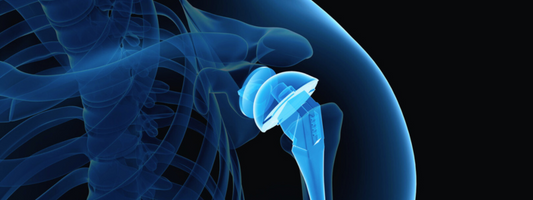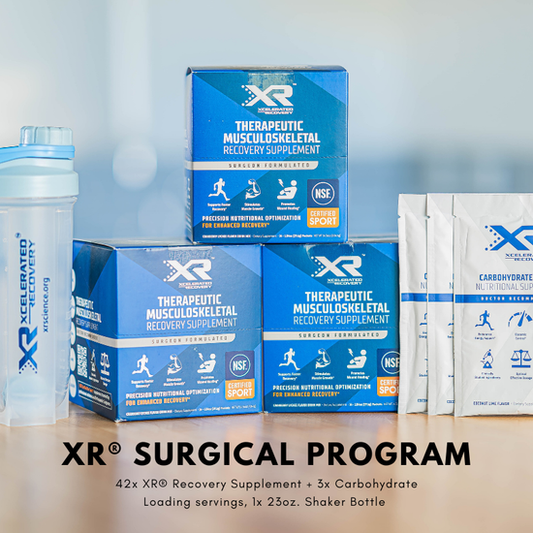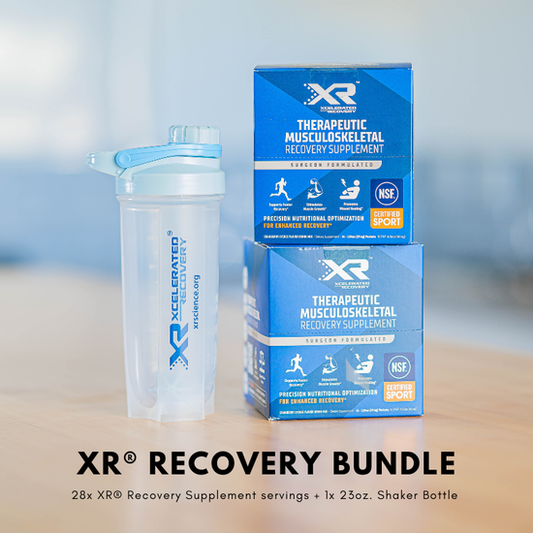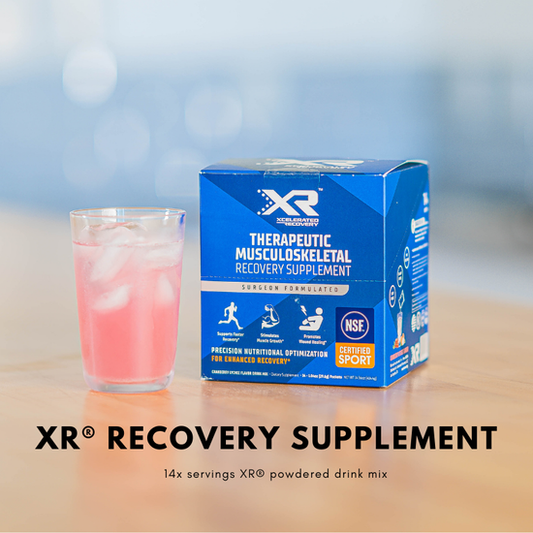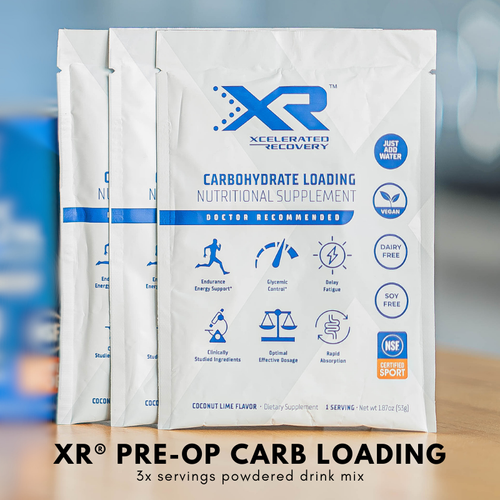
Shoulder Arthroplasty and Infection: Why Nutrition Matters
Share
Authors: Dr. Hafiz Kassam and Dr. Reza Jazayeri
Periprosthetic joint infection (PJI) after shoulder arthroplasty is one of the most difficult complications surgeons face. Despite advances in implants, surgical technique, and sterile protocols, infection remains a devastating outcome. A growing body of evidence now points to host optimization, particularly nutritional status including protein sufficiency and serum albumin as a critical and modifiable determinant of infection risk and treatment success.

Why Nutritional Status Impacts Shoulder Arthroplasty Outcomes
Patients undergoing shoulder arthroplasty—particularly older adults—frequently present with comorbidities that predispose them to poor nutritional status. Malnutrition impairs immune defense, disrupts collagen synthesis, and delays wound healing [1,2].
Surgery itself further compounds this risk by triggering a hypermetabolic, catabolic cascade characterized by protein breakdown, insulin resistance, and sharply increased amino acid demands—requirements that more than 50% of patients fail to meet [1]. Importantly, multiple studies demonstrate that perioperative nutritional optimization improves outcomes and lowers complication rates even in patients who appear “healthy” and are not overtly malnourished [1,2]. Nutritional optimization is therefore emerging as best practice for all elective arthroplasty patients, not only those deemed high risk.
For patients with established malnutrition, the stakes are higher. Emerging evidence suggests that, much like poorly controlled diabetes, elective surgery may warrant deferral until correction is achieved, given the significantly elevated complication rates in this group [3,4].
The economic impact is also profound. A single unplanned readmission can negate the margin from dozens of uncomplicated procedures [5,6]. In bundled care models, these readmissions are especially disruptive, quickly erasing institutional profitability.
At the 2025 International Consensus Meeting (ICM) on Infection, experts from over 100 countries reached strong consensus that targeted perioperative protein and amino acid supplementation reduces the risk of periprosthetic joint infection (PJI)—a paradigm shift in modern arthroplasty protocols [2].

Evidence in Shoulder Arthroplasty
Recent shoulder-specific literature underscores this connection:
- Preoperative malnutrition (albumin <3.5 g/dL, transferrin <204 mg/dL, leukopenia) was linked to higher 90-day major complications, doubled PJI risk (RR 2.0), and increased 2-year revision rates (RR 1.8) after TSA [7].
- Hypoalbuminemia correlated with longer hospital stays and higher likelihood of discharge to rehab/SNF after both primary and revision TSA [8].
- The Geriatric Nutritional Risk Index (GNRI), validated in TSA patients, strongly predicts complications, readmissions, and mortality; severe malnutrition tripled these risks [9].
Bundled payment analyses show one TSA readmission can raise episode costs from $24,666 to $48,820, effectively offsetting the profit of ~55 uncomplicated cases [5].

What We’ve Learned from Hip and Knee Arthroplasty
Although shoulder-specific data are emerging, decades of hip and knee research provide strong parallels:
- One-Stage Revision: Hypoalbuminemia independently predicted failure (OR 5.64) [10].
- Two-Stage Exchange: Albumin <3.5 g/dL doubled failure risk in hip/knee PJI treatment [11].
- DAIR procedures: Low albumin strongly correlated with recurrent infection [12].
- Nutritional risk scoring (e.g., CONUT): Moderate-to-severe deficits carried a 12-fold higher failure risk in reimplantation [13].
- Large registry studies confirm hypoalbuminemia is the most dangerous modifiable risk factor—outperforming obesity, diabetes, and smoking in predicting infection, readmission, and mortality after hip/knee arthroplasty [14,15].
Key Findings for Shoulder Arthroplasty
- Hypoalbuminemia (<3.5 g/dL) is a consistent predictor of worse outcomes and infection failure.
- Malnourished TSA patients face higher 90-day complications, doubled risk of PJI, and increased revisions.
- GNRI and albumin are powerful tools for risk stratification.
- Amino acid–based supplementation is now supported by high-level consensus for PJI prevention.
-
The financial stakes are enormous: one unplanned readmission can erase the margin from dozens of uncomplicated cases.
For shoulder arthroplasty, nutritional status is now recognized as a cornerstone of optimization—alongside infection control, surgical technique, and implant design. Shoulder-specific evidence echoes what hip and knee data have long established: poor nutrition, particularly hypoalbuminemia, doubles the risk of complications and infection.
With the ICM 2025 consensus endorsing routine nutritional screening and perioperative amino acid supplementation, these strategies should be embraced as standard best practice. Optimizing nutrition goes beyond infection prevention—it safeguards patients, enhances functional outcomes, and preserves value in contemporary orthopedic care.
References
- Hirsch KR, Wolfe RR, Ferrando AA. Pre- and Post-Surgical Nutrition for Preservation of Muscle Mass, Strength, and Functionality Following Orthopedic Surgery. Nutrients. 2021;13:1675.
- Tedesco A, Sharma AK, Acharya N, et al. The Role of Perioperative Nutritional Status and Supplementation in Orthopaedic Surgery. JBJS Rev. 2024;12(4):e23.00242.
- Johnson NR, Statz JM, Odum SM, et al. Failure to Optimize Before Total Knee Arthroplasty: Which Modifiable Risk Factor is the Most Dangerous? J Arthroplasty. 2021;36:2452-2457.
- Statz JM, Odum SM, Johnson NR, et al. Failure to Optimize Before Total Hip Arthroplasty: Which Modifiable Risk Factor Is the Most Dangerous? Arthroplasty Today. 2021;10:18-23.
- Pezzulo JD, Farronato DM, Rondon AJ, Sherman MB, Getz CL, Davis DE. Predicting Hospital Readmissions After Total Shoulder Arthroplasty Within a Bundled Payment Cohort. J Am Acad Orthop Surg. 2023;31(4):199-204.
- Khan AZ, Liu HH, Costouros JG, et al. Revision Shoulder Arthroplasty: Predictors of Subsequent Revision Surgery and Economic Burden Amongst Medicare Beneficiaries. J Shoulder Elbow Surg. 2025;34:1120-1129.
- Lawand JJ, Rizk AA, Sogbein OA, et al. Preoperative Malnutrition and Risk of 90-day Complications and 2-Year Revision After TSA. J Shoulder Elbow Surg. 2025.
- Flamant EM, Goltz DE, Burnett RA, et al. Malnutrition in Elective Shoulder Arthroplasty. J Shoulder Elbow Surg. 2022;30:2491-2497.
- Liu SH, Cerri-Droz P, Loyst RA, et al. The Geriatric Nutritional Risk Index as a Predictor of Adverse Outcomes Following TSA. JSES Int. 2024;8:152-158.
- Traverso G, Núñez JH, Gehrke T, et al. Hypoalbuminemia Increases Risk of Failure Following One-Stage Septic Revision for PJI. Arch Orthop Trauma Surg. 2023;143:5641–5648.
- Green CC, Valenzuela MM, Odum SM, et al. Hypoalbuminemia Predicts Failure of Two-Stage Exchange for Chronic Hip and Knee PJI. J Arthroplasty. 2023;38(7):1363-1368.
- Scarcella NR, Mills FB, Seidelman JL, Jiranek WA. The Effect of Nutritional Status in the Treatment of PJI in Total Hip Arthroplasty. J Arthroplasty. 2024;39(9):S225-S228.
- Li Z, Maimaiti Z, Li ZY, et al. Moderate-to-Severe Malnutrition Identified by CONUT Score and Risk of PJI Failure. Nutrients. 2022;14(20):4433.
- Johnson NR, Statz JM, Odum SM, et al. Failure to Optimize Before TKA: Hypoalbuminemia as the Most Dangerous Risk Factor. J Arthroplasty. 2021;36:2452-2457.
- Statz JM, Odum SM, Johnson NR, et al. Failure to Optimize Before THA: Hypoalbuminemia as the Most Dangerous Risk Factor. Arthroplasty Today. 2021;10:18-23.




